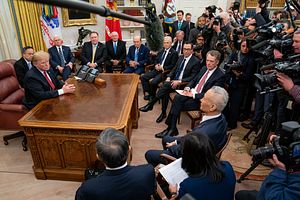U.S. President Donald Trump on Thursday talked up China’s commitment to buy more American soybeans. But the tough issues dividing the world’s two biggest economies remained unsettled after two days of meetings between U.S. and Chinese negotiators.
Trump said he expects to meet with his Chinese counterpart, Xi Jinping, to try to reach a final resolution to the six-month trade standoff.
“If we come to an agreement, there is a lot of work that has to be done,” U.S. Trade Representative Robert Lighthizer told reporters, summarizing what he said were two days and an evening of “very intense, detailed and specific discussions.”
“It’s my judgment that we made headway,” he said, declining to outline specific areas where he thought the two sides had made progress. Lighthizer reiterated that a March 1 deadline stands and said it would be up to Trump to decide how to proceed at that point if a comprehensive trade deal with China remained out of reach.
A statement from the Chinese delegation, carried by China’s state-run news agency, Xinhua, said that “Liu and Lighthizer held candid, specific and constructive discussions.” In particular, the statement said, “Both sides attach great importance to the issue of IPR [intellectual property rights] protection and technology transfer, and have agreed to further enhance cooperation in this regard.”
If the two sides fail to reach an agreement by March 1, the United States would escalate import taxes on $200 billion in Chinese goods if there was no deal. The penalties are scheduled to jump from 10 percent to 25 percent.
“He’ll make that decision when we get there,” Lighthizer said of Trump. He spoke after the talks concluded and Trump met in the Oval Office with the Chinese delegation. “The most important thing now is to continue the work.”
Trump spoke glowingly of a Chinese commitment to buy vast quantities of U.S. soybeans. But he acknowledged that he and Xi would have to reach a final agreement on the far more contentious technology issues, and said that might require more than one meeting with Xi.
“There are some points we don’t agree to, but we will agree,” the president told reporters. “I think when Xi and I meet, every point will be agreed to.”
A statement from the White House said that the “talks covered a wide range of issues,” including China’s technology transfer and intellectual property polices, cyber theft, barriers to accessing the Chinese market, and “market-distorting forces, including subsidies and state-owned enterprises.”
“The two sides showed a helpful willingness to engage on all major issues, and the negotiating sessions featured productive and technical discussions on how to resolve our differences,” the statement continued. “The United States is particularly focused on reaching meaningful commitments on structural issues and deficit reduction.”
However, despite the emphasis on structural issues in the White House statement, the only announcements about Chinese commitments focused on Beijing’s offer to buy more U.S. goods, which is Chinese leadership’s go-to response to U.S. trade complaints.
Timothy Keeler, former chief of staff at the Office of the U.S. Trade Representative, said he thinks a U.S.-China deal is possible. But “I don’t think it’s possible in the next four weeks,” said Keeler, now partner at the law firm Mayer Brown. “That’s why I tend to think both sides will do something and find a way to keep talking.”
The White House had no details on when a presidential-level meeting might take place. Trump is expected to travel to Asia in late February for another meeting with North Korean leader Kim Jong Un, though the White House has not announced a date and location for those talks.
The U.S.-China trade hostilities escalated after Trump took office, weakening both economies, shaking financial markets, and clouding the outlook for global trade. Analysts have held out little hope the two countries can reach a comprehensive deal over the next month.
At the heart of the conflict is the U.S. demand that Beijing stop taking predatory actions — from intellectual theft to the forced handover of technology by U.S. companies — in a drive to become a global power in such fields as robotics and electric cars. The Trump administration also complains that Beijing unfairly subsidizes its own tech companies.
China has denied that it deploys any such tactics.
Lighthizer, who has taken a hard line on Chinese trade practices, led the U.S. delegation. Vice Premier Liu He headed the Chinese side.
Philip Levy, senior fellow at the Chicago Council on Global Affairs and an economic adviser in President George W. Bush’s White House, said the idea of a climactic one-on-one meeting with Xi “plays very much to President Trump’s vision of himself as a master negotiator.”
But the summit will raise the stakes, put pressure on Trump not to walk away empty-handed, and make it more likely the U.S. will agree to less than it originally hoped to get from the Chinese, setting the stage for continued conflict over trade.
“It’s unlikely that we’re going to get a lasting peace,” Levy said.
By Darlene Superville and Paul Wiseman for Associated Press, with additional reporting by The Diplomat.

































